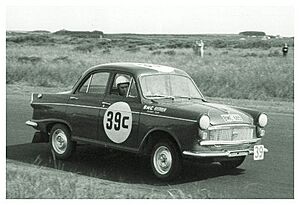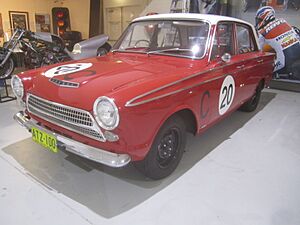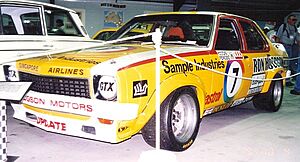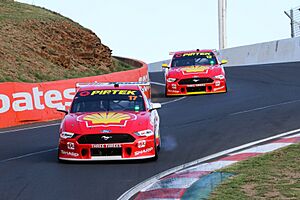Bathurst 1000 facts for kids
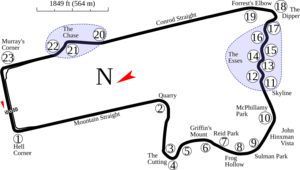 |
|
| Race Information | |
| Venue | Mount Panorama Circuit |
| Number of times held | 67 |
| First held | 1960 |
| Race Format | |
| Race 1 | |
| Laps | 161 |
| Distance | 1,000.29 km |
| Last Event (2025) | |
| Overall Winner | |
| Penrite Racing | |
| Race Winners | |
| Penrite Racing | |
The Bathurst 1000 is a famous car race held every year in Bathurst, New South Wales, Australia. It's a long race, about 1,000 kilometers (621 miles) long! People often call it The Great Race because it's so exciting and challenging. Drivers race special touring cars on the Mount Panorama Circuit. This race is a big part of the Supercars Championship, which is Australia's top car racing series.
The race started way back in 1960 as the Armstrong 500, a 500-mile race at a different track. In 1963, it moved to Bathurst and has been held there ever since. In 1973, the race distance changed to 1,000 kilometers. Winners of the race receive the Peter Brock Trophy, named after Peter Brock. He was the most successful driver in the race's history, winning nine times. He was also known as "King of the Mountain" because he was so popular and good at racing on this tough track.
Contents
Mount Panorama: The Racing Mountain
The Mount Panorama Circuit is a very special race track. It's actually made up of public roads that are closed just for the race! The track was first used for racing in 1938. It's famous for its big changes in height, with a difference of 174 meters (571 feet) between its highest and lowest points.
The race starts with a sharp left turn called Hell Corner. Then, cars speed up Mountain Straight, reaching speeds of about 255 kilometers per hour (158 mph). Next, they go through Griffin's Bend and The Cutting, which is a steep left turn. Drivers then face Reid Park, Sulman Park, and McPhillamy Park.
One of the most exciting parts is Skyline and The Esses, where cars go around corners at 220 kilometers per hour (137 mph). After The Dipper, a famous corner, cars race down Conrod Straight. This is the fastest part of the track, where cars can hit 300 kilometers per hour (186 mph)! The Chase is a long, winding section that slows cars down before the final turn, Murray's. This is the slowest part of the track before drivers cross the finish line.
Cars and Teams: The Big Rivalry
Over the years, many different types of cars have raced at Bathurst. These include production cars, which are like regular cars you might see on the road, and special touring cars. For a long time, the race was known for the big rivalry between two Australian car brands: Ford and Holden. These two brands have won almost all the races!
From 1995 to 2012, only Ford Falcons and Holden Commodores were allowed to compete. This made the rivalry even more intense! In 2013, the rules changed, and other car brands like Nissan and Mercedes-Benz started to join the race again. Holden has won the most races with 36 victories, and Ford is second with 21 wins.
A Look Back: Race History Highlights
The Beginning at Phillip Island
The race began in 1960 at the Phillip Island Grand Prix Circuit. It was called the Armstrong 500. The idea was to see which cars were the best mix of speed and reliability. Cars had to be standard, unmodified models. In the first race, Frank Coad and John Roxburgh were the first to finish in a Vauxhall Cresta.
The Phillip Island track had problems with its surface breaking up during races. This made it unsafe for the cars.
Moving to Bathurst
In 1963, the race moved to the Mount Panorama Circuit in Bathurst. Its popularity grew quickly because car makers could show off how good their cars were. Early races were won by smaller, nimble cars like the Ford Cortina and Mini Cooper. Bob Jane and Harry Firth won three times in a row from 1961 to 1963, with their last win in a Cortina GT.
In 1967, rules changed to favor bigger, more powerful cars. This led to the saying "there is no substitute for cubic inches," meaning bigger engines were better. The Ford XR Falcon GT won that year, proving the power of its V8 engine on the long straights. This started the famous Ford-Holden-Chrysler rivalry, leading to special "Bathurst Specials" like the Falcon GT-HO and Holden Monaro.
In 1968, Holden got its first Bathurst win with the Monaro GTS 327. The next year, the Monaro GTS 350 won again. The 1969 race also marked the first appearance of racing legend Peter Brock.
The 1000 Kilometer Era
In 1973, the race became 1000 kilometers long. This was also when new rules allowed more changes to the race cars, making them even faster. Allan Moffat won in a Ford Falcon GT Hardtop.
Holden's Torana cars became very successful, winning many races in the mid-1970s. In 1977, Ford had a famous 1-2 finish with Allan Moffat and Colin Bond crossing the line together.
Peter Brock became the "King of the Mountain" during this time, winning many races. He won three years in a row from 1978 to 1980 with Jim Richards. They won again from 1982 to 1984 with Larry Perkins. Dick Johnson also had a famous win in 1981 after his car hit a rock the year before, and fans helped him rebuild it.
International Cars and "Godzilla"
From 1985 to 1992, international cars like the Ford Sierra RS Cosworth and Nissan Skyline GT-R became very strong. The Nissan Skyline GT-R, nicknamed "Godzilla," was especially dominant. It had four-wheel drive and a powerful turbo engine.
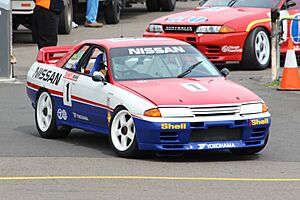
In 1992, Jim Richards and Mark Skaife won in a Nissan Skyline GT-R. The race was stopped early due to heavy rain and crashes.
The Modern Supercars Era
In 1993, new rules focused on V8-powered Ford Falcons and Holden Commodores, leading to the Supercars category we know today. The race became a single-class event in 1995.
For a couple of years (1997-1998), there were actually two different Bathurst 1000 races because of disagreements between organizers. Both races are counted in the history books!
Since 1999, the V8 Supercars have been the main event. Holden dominated the early 2000s, with Mark Skaife and Greg Murphy winning multiple times. Greg Murphy set a record lap time in 2003, known as the "Lap of the Gods."
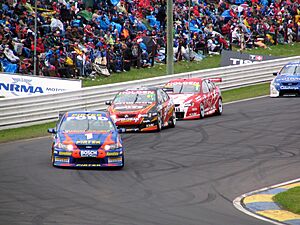
In 2006, Craig Lowndes and Jamie Whincup won for Ford, ending Holden's winning streak. They were also the first to win the Peter Brock Trophy. Lowndes and Whincup won three years in a row!
The 2014 race was very dramatic. Parts of the track surface broke up, causing a red flag (race stoppage) for repairs. Chaz Mostert and Paul Morris won that year, starting from the very last position on the grid!
In 2019, Scott McLaughlin and Alexandre Prémat won in a Ford Mustang. Their team faced some issues after the race due to a rules breach by a teammate, but their win stood. The 2020 race was special because it was the last for a factory-backed Holden team, and Shane van Gisbergen and Garth Tander won.
The 2025 Bathurst 1000 was won by Matthew Payne and Garth Tander in a Ford Mustang.
Famous Winners: Legends of the Mountain
Many drivers have become legends at Bathurst.
- Peter Brock is the most famous, with nine wins (1972, 1975, 1978–80, 1982–84, 1987). He was truly the King of the Mountain.
- Jim Richards from New Zealand has won seven times (1978–80, 1991–92, 1998, 2002). He also holds the record for the most starts in the race (35!). His son, Steven, has won five times too.
- Craig Lowndes is another fan favorite, with seven wins (1996, 2006–08, 2010, 2015, 2018). He has the most podium finishes (top three) at Bathurst, with fourteen!
- Larry Perkins has six wins (1982–84, 1993, 1995, 1997), including three with Peter Brock.
- Mark Skaife also has six wins (1991, 1992, 2001, 2002, 2005, 2010).
- Garth Tander has six wins (2000, 2009, 2011, 2020, 2022, 2025), with his most recent win in 2025.
- Bob Jane won four times in a row from 1961 to 1964.
- Allan Moffat is Ford's most successful driver, with four wins (1970, 1971, 1973, 1977).
- Jamie Whincup has won four times (2006, 2007, 2008, 2012).
- Dick Johnson won three times (1981, 1989, 1994), becoming famous after fans helped him rebuild his car in 1980.
- Greg Murphy from New Zealand has four wins (1996, 1999, 2003, 2004).
- Shane van Gisbergen from New Zealand has three wins (2020, 2022, 2023).
List of Winners
| Year | Event Name | Driver(s) | Car | Laps Elapsed time |
Race average speed |
|---|---|---|---|---|---|
| Phillip Island (500 Miles) | |||||
| 1960 | Armstrong 500 | Vauxhall Cresta | 167 laps 8h 19m 59.1s |
96.56 km/h 60.00 mph |
|
| 1961 | Armstrong 500 | Mercedes-Benz 220SE | 167 laps 8h 18m 0.0s |
96.95 km/h 60.24 mph |
|
| 1962 | Armstrong 500 | Ford XL Falcon | 167 laps 8h 15m 16.0s |
97.48 km/h 60.57 mph |
|
| Mount Panorama (500 Miles) | |||||
| 1963 | Armstrong 500 | Ford Cortina Mk.I GT | 130 laps 7h 46m 59.1s |
103.39 km/h 64.24 mph |
|
| 1964 | Armstrong 500 | Ford Cortina Mk.I GT | 130 laps | N/A | |
| 1965 | Armstrong 500 | Ford Cortina Mk.I GT500 | 130 laps 7h 16m 45.1s |
110.54 km/h 68.69 mph |
|
| 1966 | Gallaher 500 | Morris Cooper S | 130 laps 7h 11m 29.1s |
111.89 km/h 69.53 mph |
|
| 1967 | Gallaher 500 | Ford XR Falcon GT | 130 laps 6h 54m 59.1s |
116.34 km/h 72.29 mph |
|
| 1968 | Hardie-Ferodo 500 | Holden HK Monaro GTS327 | 130 laps 6h 44m 7.9s |
119.51 km/h 74.26 mph |
|
| 1969 | Hardie-Ferodo 500 | Holden HT Monaro GTS350 | 130 laps 6h 32m 25s |
123.16 km/h 76.53 mph |
|
| 1970 | Hardie-Ferodo 500 | Ford XW Falcon GTHO Phase II | 130 laps 6h 34m 26s |
122.85 km/h 76.34 mph |
|
| 1971 | Hardie-Ferodo 500 | Ford XY Falcon GTHO Phase III | 130 laps 6h 9m 49.5s |
130.55 km/h 81.12 mph |
|
| 1972 | Hardie-Ferodo 500 | Holden LJ Torana GTR XU-1 | 130 laps 6h 0m 59.1s |
133.74 km/h 83.10 mph |
|
| Mount Panorama (1,000 Kilometres) | |||||
| 1973 | Hardie-Ferodo 1000 | Ford XA Falcon GT Hardtop | 163 laps 7h 20m 6.8s |
136.33 km/h 84.71 mph |
|
| 1974 | Hardie-Ferodo 1000 | Ford XA Falcon GT Hardtop | 163 laps 7h 50m 59.1s |
127.39 km/h 79.16 mph |
|
| 1975 | Hardie-Ferodo 1000 | Holden LH Torana SL/R 5000 L34 | 163 laps 7h 19m 11.3s |
136.62 km/h 84.89 mph |
|
| 1976 | Hardie-Ferodo 1000 | Holden LH Torana SL/R 5000 L34 | 163 laps 7h 7m 12.0s |
140.45 km/h 87.27 mph |
|
| 1977 | Hardie-Ferodo 1000 | Ford XC Falcon GS500 Hardtop | 163 laps 6h 59m 7.8s |
143.15 km/h 88.95 mph |
|
| 1978 | Hardie-Ferodo 1000 | Holden LX Torana A9X SS Hatchback | 163 laps 6h 45m 53.9s |
147.82 km/h 91.85 mph |
|
| 1979 | Hardie-Ferodo 1000 | Holden LX Torana A9X SS Hatchback | 163 laps 6h 38m 15.8s |
150.65 km/h 93.61 mph |
|
| 1980 | Hardie-Ferodo 1000 | Holden VC Commodore | 163 laps 6h 47m 52.7s |
147.10 km/h 91.41 mph |
|
| 1981 | James Hardie 1000 | Ford XD Falcon | 120 laps 4h 53m 52.7s |
150.31 km/h 93.40 mph |
|
| 1982 | James Hardie 1000 | Holden VH Commodore SS | 163 laps 6h 32m 3.2s |
153.04 km/h 95.09 mph |
|
| 1983 | James Hardie 1000 | Holden VH Commodore SS | 163 laps 6h 28m 31.6s |
154.43 km/h 95.96 mph |
|
| 1984 | James Hardie 1000 | Holden VK Commodore | 163 laps 6h 23m 13.6s |
156.57 km/h 97.29 mph |
|
| 1985 | James Hardie 1000 | Jaguar XJ-S | 163 laps 6h 41m 30.19s |
149.44 km/h 92.86 mph |
|
| 1986 | James Hardie 1000 | Holden VK Commodore SS Group A | 163 laps 6h 30m 35.68s |
153.61 km/h 95.45 mph |
|
| 1987 | James Hardie 1000 | Holden VL Commodore SS Group A | 158 laps 7h 1m 8.4s |
139.82 km/h 86.88 mph |
|
| 1988 | Tooheys 1000 | Ford Sierra RS500 | 161 laps 7h 2m 10.28s |
142.12 km/h 88.31 mph |
|
| 1989 | Tooheys 1000 | Ford Sierra RS500 | 161 laps 6h 30m 53.44s |
153.50 km/h 95.38 mph |
|
| 1990 | Tooheys 1000 | Holden VL Commodore SS Group A SV | 161 laps 6h 40m 52.64s |
149.67 km/h 93.00 mph |
|
| 1991 | Tooheys 1000 | Nissan Skyline BNR32 GT-R | 161 laps 6h 19m 14.80s |
158.21 km/h 98.31 mph |
|
| 1992 | Tooheys 1000 | Nissan Skyline BNR32 GT-R | 143 laps 6h 27m 16.22s |
137.61 km/h 85.51 mph |
|
| 1993 | Tooheys 1000 | Holden VP Commodore | 161 laps 6h 29m 6.69s |
154.19 km/h 95.81 mph |
|
| 1994 | Tooheys 1000 | Ford EB Falcon | 161 laps 7h 3m 45.8425s |
141.5882 km/h 87.9788 mph |
|
| 1995 | Tooheys 1000 | Holden VR Commodore | 161 laps 6h 20m 32.4766s |
157.6701 km/h 97.9717 mph |
|
| 1996 | AMP Bathurst 1000 | Holden VR Commodore | 161 laps 7h 9m 28.3584s |
139.7062 km/h 86.8094 mph |
|
| 1997 | AMP Bathurst 1000 | BMW 320i | 161 laps 6h 41m 25.4072s |
149.4681 km/h 92.8752 mph |
|
| 1997 | Primus 1000 Classic | Holden VS Commodore | 161 laps 6h 21m 55.5483s |
157.0986 km/h 97.6165 mph |
|
| 1998 | AMP Bathurst 1000 | Volvo S40 | 161 laps 6h 54m 23.4756s |
144.7907 km/h 89.9688 mph |
|
| 1998 | FAI 1000 | Ford EL Falcon | 161 laps 6h 42m 23.9039s |
149.1060 km/h 92.6501 mph |
|
| 1999 | FAI 1000 | Holden VT Commodore | 161 laps 6h 51m 48.8354s |
145.6969 km/h 90.5318 mph |
|
| 2000 | FAI 1000 | Holden VT Commodore | 161 laps 7h 23m 30.2348s |
135.3259 km/h 84.0876 mph |
|
| 2001 | V8 Supercar 1000 | Holden VX Commodore | 161 laps 6h 50m 33.1789s |
146.1872 km/h 90.8365 mph |
|
| 2002 | Bob Jane T-Marts 1000 | Holden VX Commodore | 161 laps 6h 58m 41.0260s |
143.3482 km/h 89.0724 mph |
|
| 2003 | Bob Jane T-Marts 1000 | Holden VY Commodore | 161 laps 6h 32m 55.4044s |
152.7463 km/h 94.9121 mph |
|
| 2004 | Bob Jane T-Marts 1000 | Holden VY Commodore | 161 laps 6h 29m 36.2055s |
154.0479 km/h 95.7209 mph |
|
| 2005 | Supercheap Auto 1000 | Holden VZ Commodore | 161 laps 6h 37m 17.0012s |
151.0700 km/h 93.8705 mph |
|
| 2006 | Supercheap Auto Bathurst 1000 | Ford BA Falcon | 161 laps 6h 59m 53.5852s |
142.9354 km/h 88.8159 mph |
|
| 2007 | Supercheap Auto Bathurst 1000 | Ford BF Falcon | 161 laps 6h 29m 10.1985s |
154.2195 km/h 95.8275 mph |
|
| 2008 | Supercheap Auto Bathurst 1000 | Ford BF Falcon | 161 laps 6h 26m 0.4291s |
155.4831 km/h 96.6127 mph |
|
| 2009 | Supercheap Auto Bathurst 1000 | Holden VE Commodore | 161 laps 6h 40m 2.4884s |
150.0284 km/h 93.2233 mph |
|
| 2010 | Supercheap Auto Bathurst 1000 | Holden VE Commodore | 161 laps 6h 12m 51.4153s |
160.9668 km/h 100.0201 mph |
|
| 2011 | Supercheap Auto Bathurst 1000 | Holden VE Commodore | 161 laps 6h 26m 52.2691s |
155.0904 km/h 96.3294 mph |
|
| 2012 | Supercheap Auto Bathurst 1000 | Holden VE Commodore | 161 laps 6h 16m 1.3304s |
159.6118 km/h 99.1782 mph |
|
| 2013 | Supercheap Auto Bathurst 1000 | Ford FG Falcon | 161 laps 6h 11m 27.9315s |
161.5697 km/h 100.3948 mph |
|
| 2014 | Supercheap Auto Bathurst 1000 | Ford FG Falcon | 161 laps 7h 58m 53.2052s |
125.3273 km/h 77.8914 mph |
|
| 2015 | Supercheap Auto Bathurst 1000 | Holden VF Commodore | 161 laps 6h 16m 7.7064s |
159.5667 km/h 99.1714 mph |
|
| 2016 | Supercheap Auto Bathurst 1000 | Holden VF Commodore | 161 laps 6h 19m 25.3237s |
158.1816 km/h 98.3105 mph |
|
| 2017 | Supercheap Auto Bathurst 1000 | Holden VF Commodore | 161 laps 7h 11m 45.5456s |
139.0071 km/h 86.3844 mph |
|
| 2018 | Supercheap Auto Bathurst 1000 | Holden ZB Commodore | 161 laps 6h 1m 44.8637s |
165.9100 km/h 103.0917 mph |
|
| 2019 | Supercheap Auto Bathurst 1000 | Ford Mustang GT | 161 laps 6h 27m 51.5260s |
154.7408 km/h 96.1515 mph |
|
| 2020 | Supercheap Auto Bathurst 1000 | Holden ZB Commodore | 161 laps 6h 10m 56.1143s |
161.8006 km/h 100.5385 mph |
|
| 2021 | Repco Bathurst 1000 | Holden ZB Commodore | 161 laps 6h 15m 6.1952s |
160.0028 km/h 99.4211 mph |
|
| 2022 | Repco Bathurst 1000 | Holden ZB Commodore | 161 laps 6h 41m 53.7220s |
149.3363 km/h 92.7933 mph |
|
| 2023 | Repco Bathurst 1000 | Chevrolet Camaro ZL1-1LE | 161 laps 6h 7m 07.4957s |
163.4800 km/h 101.5818 mph |
|
| 2024 | Repco Bathurst 1000 | Chevrolet Camaro ZL1-1LE | 161 laps 5h 58m 3.0649s |
167.6230 km/h 104.1561 mph |
|
| 2025 | Repco Bathurst 1000 | Ford Mustang S650 | 161 laps 6h 52m 14.938s |
145.5459 km/h 90.4421 mph |
|
Notes:
* The overall race winner was not officially recognized until 1965. Before that, results showed winners for different car classes. The first car to cross the finish line has been called the overall winner since then. * Some races were stopped before the full distance was completed. * In some races, the first or second place finishers were disqualified after the race. * The 1987 race was the first year with "The Chase" added to Conrod Straight to improve safety. * The 2014 race was stopped for over an hour because the track surface needed repairs. This stoppage time is included in the total race time. * The 2016 race winner received a time penalty after the race for breaking driving rules. * The 2024 race holds the record for the fastest time elapsed and highest average speed.
Records and Statistics
Most Wins by Driver
| Wins | Driver | Years |
|---|---|---|
| 9 | 1972, 1975, 1978, 1979, 1980, 1982, 1983, 1984, 1987 | |
| 7 | 1978, 1979, 1980, 1991, 1992, 1998, 2002 | |
| 1996, 2006, 2007, 2008, 2010, 2015, 2018 | ||
| 6 | 1982, 1983, 1984, 1993, 1995, 1997 | |
| 1991, 1992, 2001, 2002, 2005, 2010 | ||
| 2000, 2009, 2011, 2020, 2022, 2025 | ||
| 5 | 1998, 1999, 2013, 2015, 2018 | |
| 4 | 1961, 1962, 1963, 1964 | |
| 1961, 1962, 1963, 1967 | ||
| 1970, 1971, 1973, 1977 | ||
| 1996, 1999, 2003, 2004 | ||
| 2006, 2007, 2008, 2012 | ||
| 3 | 1981, 1989, 1994 | |
| 2020, 2022, 2023 | ||
| 2 | 1974, 1985 | |
| 1986, 1990 | ||
| 1989, 1994 | ||
| 1995, 1997 | ||
| 1988, 2001 | ||
| 2003, 2004 | ||
| 2009, 2016 | ||
| 2014, 2021 |
Most Wins by Manufacturer
| Wins | Manufacturer |
|---|---|
| 36 | Holden |
| 21 | Ford |
| 2 | Chevrolet |
| Nissan |
Race Records
| Description | Record | Driver/s | Car | Year |
|---|---|---|---|---|
| Race record | 5:58:03 (161 laps) |
Chevrolet Camaro | 2024 | |
| Lap record | 2:04.7602 | Ford Mustang GT | 2019 | |
| Largest winning margin | 6 laps | Holden LX Torana SS A9X Hatchback | 1979 | |
| Smallest winning margin | 0.1434s | Holden VF Commodore | 2016 |
Driver Records
Safety on the Track
Car racing is an exciting sport, but it can also be very challenging. Over the many years of the Bathurst 1000, there have been times when drivers were seriously hurt or passed away during races or practice. These sad events have always led to important safety improvements on the track and in the cars.
For example, in 1986, a driver named Mike Burgmann had an accident on Conrod Straight. After this, a new section called "The Chase" was added to the straight in 1987. This change helped slow the cars down before a fast corner, making the track safer for everyone. A plaque at "The Chase" remembers Mike Burgmann.
In 1992, Denny Hulme, a former Formula One World Champion, had a medical emergency while driving and passed away. His car came to a stop safely, but it was a reminder of the health challenges drivers can face. In 1994, Don Watson passed away during practice after a mechanical problem with his car.
These events, and others like the passing of Mark Porter in a support race in 2006, remind us that safety is always the top priority in motorsport. Race organizers and teams work hard to make sure drivers are as safe as possible.
Peter Brock Trophy
Peter Brock was a true legend of the Bathurst 1000. He passed away in an accident during a rally event in 2006, just weeks before the Bathurst 1000 race that year. To honor him, Supercars announced that the winners of the Bathurst 1000 would now receive the Peter Brock Trophy.
The 2006 race had many special tributes to Brock. The front row of the starting grid was left empty, and all cars had a special '05' number sticker, which was Brock's famous car number. His past co-drivers also did a special lap of honor in cars he had won Bathurst with. The trophy itself is inscribed with "King of the Mountain," his famous nickname. Craig Lowndes, who was mentored by Brock, has won this trophy a record six times.
Event Sponsors
The Bathurst 1000 has had different main sponsors over the years:
- 1960–65: Armstrong
- 1966–67: Gallaher
- 1968–87: James Hardie
- 1968–80: Hardie-Ferodo
- 1981–87: James Hardie
- 1988–95: Tooheys
- 1996–98: AMP
- 1997: Primus
- 1998–2000: FAI
- 2002–04: Bob Jane T-Marts
- 2005–20: Supercheap Auto
- 2021–present: Repco
Images for kids
See also
 In Spanish: 1000 km de Bathurst para niños
In Spanish: 1000 km de Bathurst para niños
- List of Bathurst 1000 vehicles
- National Motor Racing Museum – a museum located next to the racing circuit.
- Bathurst 12 Hour
- List of Australian Touring Car Championship races



